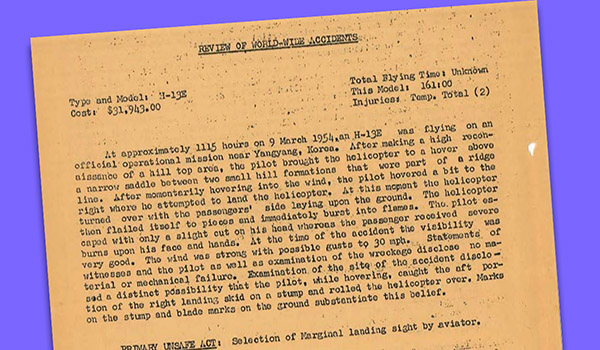
Looking Back / By Mark Albertson: From the editor: The entry below is from “Accidents,” a column which appeared in the pre-Army Aviation publication, The Army Aviator, Vol. 3, No. 6, page 14, June 1954, for those readers who would care indulge the Army Aviation archives.
- Type and Model: H-13E
- Total Flying Time: Unknown
- Cost: $31,943.00
- This Model: 161:00
- Injuries: Temp. Total (2)

At approximately 1115 hours on 9 March 1954, an H-13E was flying on an official operational mission near Yangyang, Korea. After making a high reconnaissance of a hill top area, the pilot brought the helicopter to a hover above a narrow saddle between two small hill formations that were part of a ridge line. After momentarily hovering into the wind, the pilot hovered a bit to the right where he attempted to land the helicopter. At this moment the helicopter turned over with the passenger’s side laying upon the ground. The helicopter then flailed itself to pieces and immediately burst into flames. The pilot escaped with only a slight cut on his head whereas the passenger received severe burns upon his face and hands. At the time of the accident the visibility was very good. The wind was strong with possible gusts to 30 mph. Statements of witnesses and the pilot as well as examination of the wreckage disclose no material or mechanical failure. Examination of the site of the accident disclosed a distinct possibility that the pilot, while hovering, caught the aft portion of the right landing skid on a stump and rolled the helicopter over. Marks on the stump and blade marks on the ground substantiate this belief.
- PRIMARY UNSAFE ACT: Selection of marginal landing site by aviator.
- UNSAFE PHYSICAL CONDITION: The selection of landing site was marginal.
- CONTRIBUTING FACTORS: Strong and gusty winds with possible gusts to 30 mph.
- ACTION TAKEN: All helicopter pilots briefed on dangers of landing on unapproved helicopter landing pads.
- RECOMMENDED FURTHER ACTION: No further action recommended. Flying technique and judgment was involved and can be corrected in this instance only by added experience.
- STATEMENT OF REVIEWING OFFICIAL: No further action recommended.








